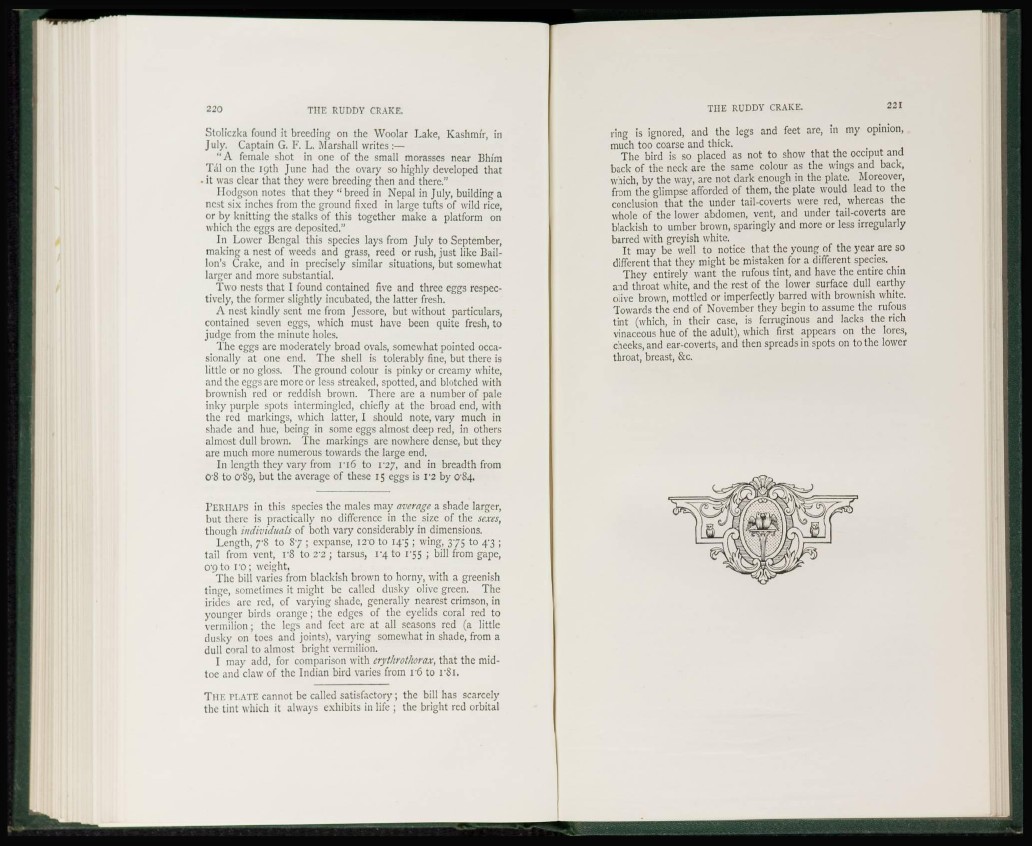
Stoliczka found it breeding on the Woolar Lake, Kashmir, in
July. Captain G. F. L. Marshall writes :—
" A female shot in one of the small morasses near Bhim
Tal on the 19th June had the ovary so highly developed that
it was clear that they were breeding then and there."
Hodgson notes that they "breed in Nepal in July, building a
nest six inches from the ground fixed in large tufts of wild rice,
or by knitting the stalks of this together make a platform on
which the eggs are deposited."
In Lower Bengal this species lays from July to September,
making a nest of weeds and grass, reed or rush, just like Bail-
Ion's Crake, and in precisely similar situations, but somewhat
larger and more substantial.
Two nests that I found contained five and three eggs respectively,
the former slightly incubated, the latter fresh.
A nest kindly sent me from Jessore, but without particulars,
contained seven eggs, which must have been quite fresh, to
judge from the minute holes.
The eggs are moderately broad ovals, somewhat pointed occasionally
at one end. The shell is tolerably fine, but there is
little or no gloss. The ground colour is pinky or creamy white,
and the eggs arc more or less streaked, spotted, and blotched with
brownish red or reddish brown. There are a number of pale
inky purple spots intermingled, chiefly at the broad end, with
the red markings, which latter, I should note, vary much in
shade and hue, being in some eggs almost deep red, in others
almost dull brown. The markings are nowhere dense, but they
are much more numerous towards the large end.
In length they vary from r i 6 to r27, and in breadth from
0'8 to o'Sa, but the average of these 15 eggs is V2 by 0'84.
PERHAPS in this species the males may average a shade larger,
but there is practically no difference in the size of the sexes,
though individuals of both vary considerably in dimensions.
Length, 7'8 to 87 ; expanse, 120 to I4'5 ; wing, 375 to 4*3 ;
tail from vent, r8 to 2'2 ; tarsus, i- 4 to 1 '5 5 ; bill from gape,
o"9 to ro ; weight,
The bill varies from blackish brown to horny, with a greenish
tinge, sometimes it might be called dusky olive green. The
irides are red, of varying shade, generally nearest crimson, in
younger birds orange ; the edges of the eyelids coral red to
vermilion ; the legs and fect are at all seasons red (a little
dusky on toes and joints), varying somewhat in shade, from a
dull coral to almost bright vermilion.
I may add, for comparison with crythrothorax, that the midtoe
and claw of the Indian bird varies from 16 to 1 SI.
THE PLATE cannot be called satisfactory ; the bill has scarcely
the tint which it always exhibits in life ; the bright red orbital
ring is ignored, and the legs and feet are, in my opinion,
much too coarse and thick.
The bird is so placed as not to show that the occiput and
back of the neck are the same colour as the wings and back,
which, by the way, are not dark enough in the plate. Moreover,
from the glimpse afforded of them, the plate would lead to the
conclusion that the under tail-coverts were red, whereas the
whole of the lower abdomen, vent, and under tail-coverts are
blackish to umber brown, sparingly and more or less irregularly
barred with greyish white.
It may be well to notice that the young of the year are so
different that they might be mistaken for a different species.
They entirely want the rufous tint, and have the entire chin
and throat white, and the rest of the lower surface dull earthy
olive brown, mottled or imperfectly barred with brownish white.
Towards the end of November they begin to assume the rufous
tint (which, in their case, is ferruginous and lacks the rich
vinaceous hue of the adult), which first appears on the lores,
cheeks, and ear-coverts, and then spreads in spots on to the lower
throat, breast, &c.